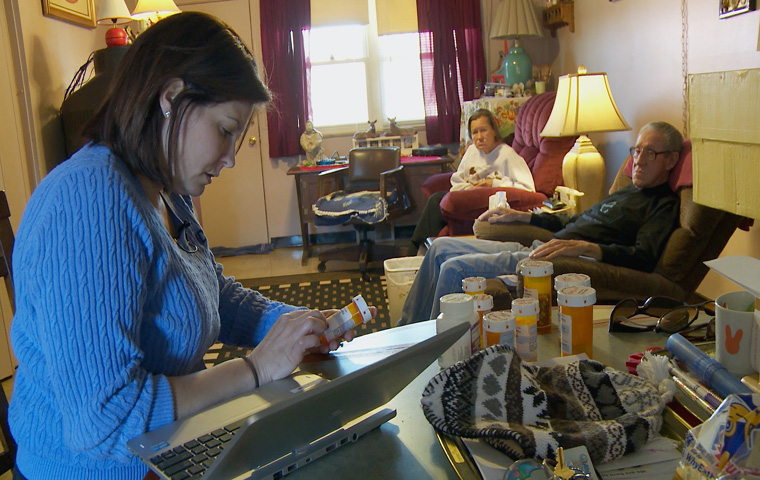Film makes ‘Invisible Patients’ visible
Locally-produced documentary showcases in-home care
Nurse practitioner Jessica MacLeod studies a prescription pill bottle in the home of Wink and Patty Sherill. The Sherill’s are two of the subjects in “The Invisible Patients.” After being found without their prescriptions in their system they were no longer supported by their doctor.
During her first week as an in-home nurse practitioner Jessica MacLeod almost quit.
MacLeod said the discomfort of entering a stranger’s home, the complexity of their medical needs and the emotional drain made her rethink her decision to leave the traditional setting of a doctor’s office where she once worked.
But the former USI nursing instructor stuck with it and now she and four of her patients are the subjects of the documentary “The Invisible Patients.”
The film features Wink and Patty Sherill, a couple with multiple chronic conditions who were no longer accepted by their physician after failing a drug test, Roger, a man who throughout the film is in the process of dying from Duchenne’s Muscular Dystrophy and Ron, a man who lives with complications from injuries he sustained in a motorcycle accident.
“I was very excited (to be approached about the film),” MacLeod said. “In my mind I thought it was a story or a set of stories that really needed to be shown to a wider audiences.”
She was approached by her friend Patrick O’Connor, a local writer, director and producer and former university English adjunct.
O’Connor said the stories that MacLeod would tell him about her work were often shocking. The idea for the film built from his initial curiosity into patients’ situations.
He and MacLeod approached some of her patients and after explaining their idea they began filming. O’Connor and his videographer, university alum Jordan Barclay shot the film over nine to 10 months.
“It was an incredible privilege to be allowed into that intimate space,” O’Connor said. “In the beginning I was very self conscious. I was working really hard to not be intrusive.”
He said he could feel that MacLeod and the patients knew the cameras were there, but that soon faded away.
“There are moments where I’m convinced they forgot we were even in the room,” he said.
O’Connor said MacLeod has the incredible ability to listen to people and that led the patients to fully trust her.
“She really cares about these people as people,” he said. “In order for that to happen you have to listen to them.”
On a daily basis MacLeod said she sees “incredible poverty.”
She sees people living in homes that should be condemned and people who choose each day between food and medication.
It was not the original intentions of the film, but it ended up being a call to action for the types of patients it portrays.
“Patrick made a conscious decision to not have any agenda in mind (when starting filming),” MacLeod said. “He didn’t want it to be a political piece.”
O’Connor said it really shows that the healthcare system needs a “good, solid” way to take care of people who cannot get out and utilize traditional health care.
“I think that the change was really having people understand that there are people out in our communities that really struggle to get health care,” he said.
The film won the Audience Choice award at the Indy Film Festival and has received positive reactions from the audiences who have seen it so far, including the film’s subjects.
“I’m so proud of it. The audience reaction has been overwhelming,” MacLeod said. “They cry, they laugh. They really respect the work.”



